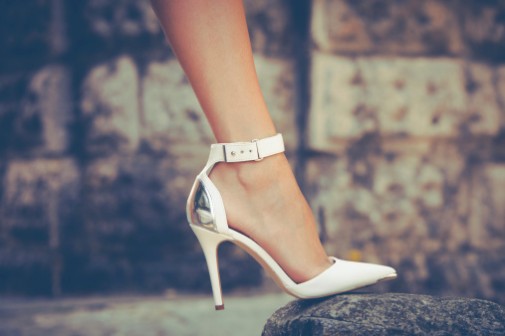Flip-flops vs. high heels

Don’t dis the heels! At least, not yet.
When it comes to feet, Carrie Bradshaw, the New York City newspaper columnist who had a proclivity for high-heel designer shoes in the HBO sitcom, Sex and the City, may have been on to something. Could it be that heels may be better than flat flip-flops?
Many women assume high heels are harder on their feet than flip-flops, but experts say that’s a huge misconception and that heels may have a height advantage over flip-flops. In fact, heels just may prove to be the lesser of two evils.
The American Podiatric Medical Association indicates that warm weather is associated with an increase in tendinitis, stress fractures, sprained ankles and other injuries, oftentimes attributed to America’s favorite summer footwear—the flip-flop.
According to one foot expert, flip-flops are completely unsupportive to the hindfoot, midfoot and forefoot. The toes of the flip-flop wearer continually grasp at the ground/forefoot of the shoe to remain in the shoe, which lacks the enclosure or security needed for additional protection. The stress on the toes may cause further straining of the tendons, and the lack of support can create unstable motion in the foot.
Dr. Laura Linde, a podiatrist at Advocate Christ Medical Center in Oak Lawn, Ill., says, during the summer months, she sees an influx of patients injured as a result of wearing flip-flops, sandals or shoes with little to no support. The patients are predominantly adolescents and females in the 20 to 30 age range.
“The most common injuries are tendinitis, particularly tendinitis of the Achilles tendon, peroneal tendinitis, and posterior tendon tendinitis; plantar fasciitis; lateral ankle injuries and strains; exacerbation of inflammation in the joints; and fractures and stress fractures,” Dr. Linde says. “It is very common to see fractures involving the fifth metatarsal base and stress fractures.”
Dr. Linde recommends that if you are going to select flip-flops as the shoe of choice for a day or event, minimize the amount of time you spend wearing it. Flip-flops are intended only for short durations of wear and minimal amounts of ambulation and activity. These shoes should not be worn for extensive walking, working out, traveling or standing, to prevent potential complications and limit the strain on the joints, ligaments and tendons of the foot and the ankle.
Even though research focuses on flip-flops, high heels can be a danger as well.
“High heels definitely put the foot in a stilted, unnatural position, in which the foot becomes more unstable in uneven terrain, thereby increasing a person’s risk for lateral ankle injuries to the soft tissues and bones,” warns Dr. Linde.
She adds that anyone noticing pain along the bottom of the foot or in the ankle area should immediately refrain from using flip-flops or unsupportive shoe gear.
Related Posts
Comments
4 Comments
About the Author
health enews staff is a group of experienced writers from our Advocate Health Care and Aurora Health Care sites, which also includes freelance or intern writers.



















Flips flops are horrible NO support Like walking barefoot or worse Your feet will suffer over time Get Rid of Flip flops er
I’ve always said that high heels are more comfortable on me than flip flops. Glad to see that there is some truth to the topic.
I am guilty of wearing flip-flops when running errands but will keep in mind they are only meant for short durations!
How about a compromise? When I’m not wearing my Reebok walking shoes with casual clothes or sensible 2-inch heels with a suit or a dress, during the summer I’m wearing 1.5-inch espadrilles with Spenco poysorb total support sport insoles; and the rest of the year, it’s the same insoles in regular or driving moccasins or in loafers with 1-inch heels, especially at home. Those insoles really work!